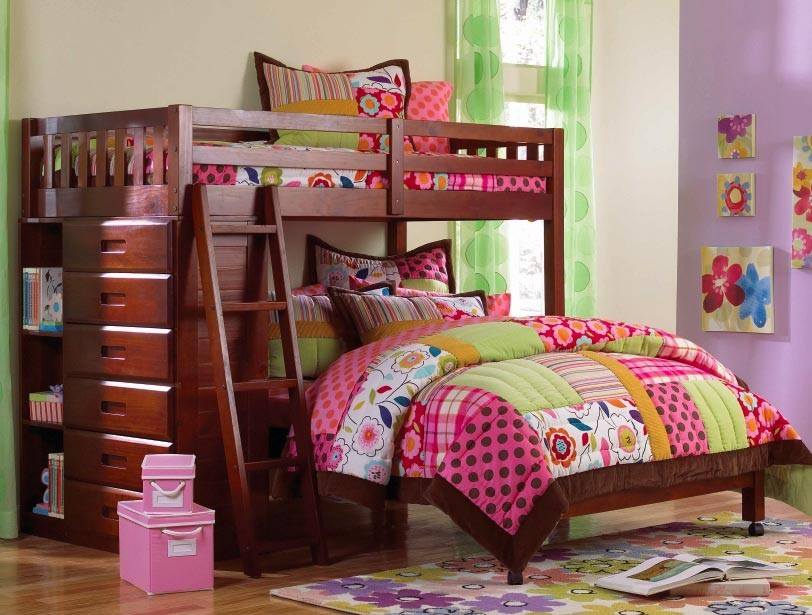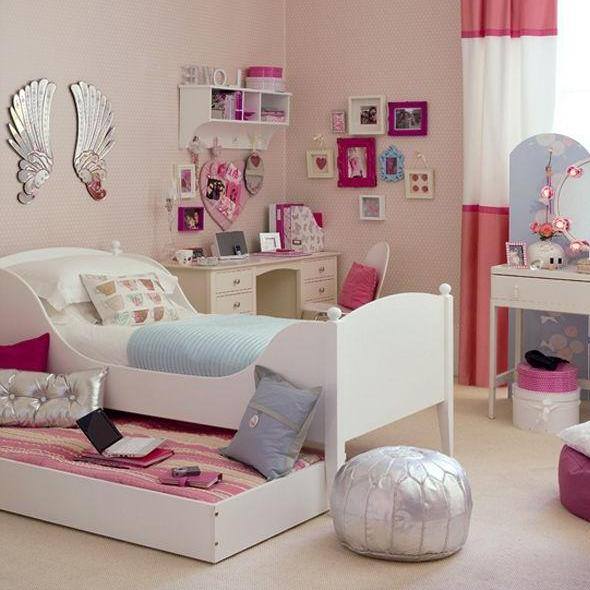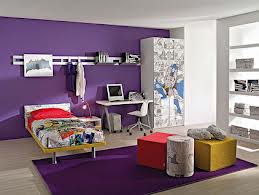
The nursery – a place to dream Best Interior Designer near me
Girl’s Room Design
Designing a bedroom is difficult and easy. Each room has its own characteristics depending on the occupants. Parent’s room is different from the child’s room. Likewise, girls’ rooms and boys’ rooms. This description will discuss the details of the design of the children’s room, especially for girls.
How to design a girl’s room?
Girls’ rooms are generally more aesthetic than boys’ rooms, so the following general things need to be considered before designing.
Theme
Is a core point before designing? The theme of royal princesses, favorite cartoons, dolls or flowers is usually the dominant choice for girls.
Color
Color plays an important role in determining whether or not the room is ‘lively’. Choose cheerful colors like pink, yellow, and orange, navy blue or combine them to make them look alive.
Furniture
Adjust the furniture with the theme of the room. To make it easier, buy a package of 1 set consisting of a bed, wardrobe, study/dressing table and drawers. Just need to add a little touch to emphasize the theme.
Decoration/Makeup
Aims to emphasize the theme. For example, by adding wallpaper or special stickers in the closet. This method is quite practical and profitable because it can be replaced whenever you get bored.
Girls generally have a calmer nature and they will tend to follow your wishes. Even so, invite your little daughter to discuss the things above and arrange the room to make it more fun.
Minimalist girl’s bedroom
Spacious limitations are not an obstacle to getting a comfortable and elegant room design. It’s just a matter of tricks to make the illusion wider, space saving and furniture to store things creatively. The key is in the arrangement of the room, coloring, lighting, selection of furniture and accessories. In an instant a minimalist room will be different.
Coloring
Rooms with limited land should not use many colors. This only makes it look narrower and denser. Use neutral colors such as white, pastel, light blue and beige on the walls of the room. Not only soothing, these colors are proven to have a broad effect on a room.
Themes
Choose a theme, for example Hello Kitty. The soft pink color combined with white is still suitable for a minimalist room.
Give a touch of pattern to the carpet, bed cover, or curtains to bring it to life. If it’s still lacking, add wallpaper or wall makeup.
Furniture
It is important to take into account the size of furniture such as wardrobes, study/dressing tables, and beds for minimalist rooms. Do not let the size of the bed take up almost part of the room. Choose a single bed. There is no need to buy a bed with many ornaments that are difficult to clean, move or move. Press the bed against the wall to save space.
The advantage of a single bed is that the design is timeless so that it can still be used even if the child has grown up.
Lighting
Good lighting helps make the room look spacious. Even though it looks attractive, avoid using lights like in a discotheque which will only make the room look cramped. Eliminate the dark parts of the room with sufficient light from inside and outside. In addition to healthy sunlight, it also helps kill germs and bacteria in the room.
Mirror
Place/hang a mirror that is large enough, for example 50×75 cm on the bedroom wall. Mirrors are often used in interiors to make the illusion of a room appear larger.
Sliding door
Use a sliding door (sliding door) instead of a regular door. This door model creates a broad impression because when opening or closing the door does not take up space.
Color Selection
Choosing the right color will affect the appearance of the room. Neutral colors are very suitable to be applied in all types of rooms including bedrooms, including white, beige, light blue, pastel, soft pink, and soft peach. Choose colors according to the theme and personality of the child, if necessary, invite your child to discuss to understand his wishes.
Boys are generally more active and cheerful when choosing colors must be selective. Here are some of the most frequently used color combinations for boys’ bedroom paints quoted from a wall paint site.

A girl’s bedroom Best Interior Designer near me
Blue and White
Blue is almost the color choice of all boys’ rooms. In terms of effect, blue is considered able to make the occupants of the room feel cool, relaxed, and able to create the impression of wisdom. The dark blue color gradation has a character that can arouse the imagination, create a feeling of calm and increase sensitivity, and encourage enthusiasm. While the light blue color (pale blue) gives the impression of being light, calm, and serene.
Apply this color dominantly on the bedroom walls and then combine it with white. Besides representing masculinity, blue itself is synonymous with freedom and an imaginative impression, making it suitable for both boys and men.
As one of the earth tone color categories, blue also creates shade and coolness. When combined create a natural atmosphere and build a positive mood. The application of this color combination on the walls of the children’s room makes a minimalist room look relieved.
Red Shades
In accordance with the meaning of the color, which is brave, tough, and has a strong character, red is also suitable in a boy’s bedroom. We indirectly create an atmosphere that fosters children’s mentality from an early age to become winners, brave and tough.
The red color is suitable to be combined with moss green, bright yellow, white or blue. What needs to be considered is the color composition so that it doesn’t look too flashy. Color compositions that are too extreme or vice versa can damage and affect the mood of the occupants of the room, so discuss it with the experts.
Shades of green/lemon green
The application of lemon green shades in the room can create a fresh atmosphere. Suitable when applied to the walls of the room plus pictures or makeup of certain characters according to the child’s favorite theme.
Other colors that are also suitable to be applied in a boy’s room are orange, yellow, white and beige.
As a color with a bright tone, orange is able to make a child’s bedroom look attractive and full of joy. Orange is also able to give a warm touch and increase children’s creativity.
When applying orange, you should combine it with white because the two colors look contrasting but offset each other. Use orange on walls or furniture and room furnishings.
The orange color will stand out more when applied to only one part of the wall, while the other parts use white. Repeat the combination of the two colors in the bed area. For example, choose a white bed with storage drawer pulls at the bottom and the head of the bed is patterned with orange and white vertical stripes. To make it look livelier, you can combine it with yellow sheets and pillows with cartoon images.

The perfect space for a child Best Interior Designer near me
Furniture and bed design
Align the bed and bedroom furniture with the theme. As discussed earlier, girls usually like princess themes, favorite cartoon characters, dolls or flowers. Back to the Hello Kitty theme, no need to design exactly one hundred percent. Simply present the nuances through wall colors, stickers or wall wallpapers that are easy to remove/replace. Or by giving a pattern to the curtains or bedroom bed covers.
To facilitate the overall application, choose a set room according to the theme, namely pink and white. The set room consists of 1 bed, 1 wardrobe and 1 dressing table or regular table plus wall coloring.
Choose a multi functional single bed/bed. The bed has a sliding drawer underneath, which can be used as storage for extra mattresses or other items. Adding a few drawers under the bed has also proven to be effective as a means of storing children’s toys, dolls or spare pillows. The size of the drawer is adjusted to the size of the bed.
The advantage of a single bed is that its function is timeless so it can still be used even though the child has grown up.
Likewise, the wardrobe that functions as a place to store clothes and other items must be in harmony with the theme of the room. Use standard rectangular or rectangular cabinets by adding modifications to the front using stickers or makeup sticks that are easy to remove/remove.
For a study table and a seat, choose a practical one according to the size of the room. For example, a table measuring 80 cm x 50 cm is sufficient to accommodate the needs of a minimalist room. Complete the desk with a small drawer on the top and a large one on the bottom for storing books and school supplies.
The seat should be padded with foam so that it is comfortable when occupied and does not get more easily. If possible, add a small shelf above the study table to put books or light reading for children. Or it could be by sticking elbow nails on the wall instead of a table shelf.
Next is a mini dressing table (if any). To emphasize, modify the table according to the theme of the room then combine it with elegant knick-knacks to add a cheerful impression. Complete the table with small drawers that are useful for storing hair accessories, toys or children’s favorite items.
Last and not least is free space (free space) to play. It is usually located on the floor of the room beside or in front of the bed. Put a small rug measuring 120 cm x 100 cm as a seat so that your child and his friends can work freely. Complete with small pillows for backrest or lying down.


